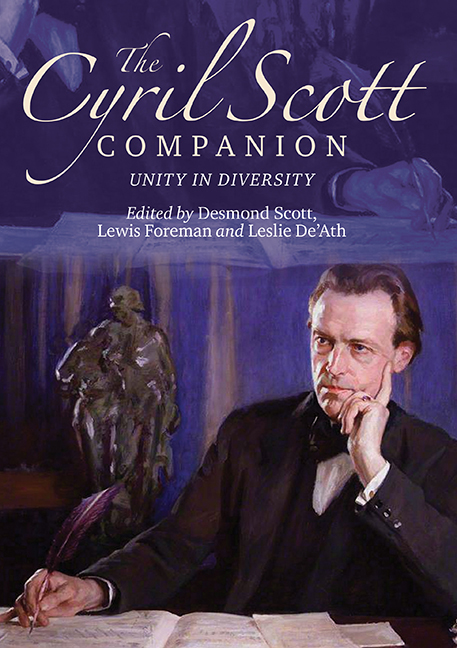Book contents
- Frontmatter
- Dedication
- Contents
- List of Illustrations
- List of Tables
- List of Contributors
- Foreword
- Preface
- Acknowledgements
- Editors' Note
- I SCOTT IN CONTEXT
- II THE MUSIC
- 8 Discovering, Editing and Recording Cyril Scott
- 9 ‘Years of Indiscretion’: The Early Piano Works, 1898–1909
- 10 ‘Like a Bird Sings’: The Piano Works from the Op. 66 Sonata to World War 1
- 11 The Later Piano Works
- 12 The Twenty-First-Century Orchestral Recordings: The Shock of the Unknown
- 13 The Chamber Music
- 14 Operas and Music for the Theatre
- 15 The Choral Works
- 16 The Songs
- III THE WRITINGS
- IV PERSONAL REMINISCENCES
- APPENDICES
- CATALOGUES, DISCOGRAPHY AND BIBLIOGRAPHY
- Index of Works
- General Index
9 - ‘Years of Indiscretion’: The Early Piano Works, 1898–1909
from II - THE MUSIC
Published online by Cambridge University Press: 14 September 2019
- Frontmatter
- Dedication
- Contents
- List of Illustrations
- List of Tables
- List of Contributors
- Foreword
- Preface
- Acknowledgements
- Editors' Note
- I SCOTT IN CONTEXT
- II THE MUSIC
- 8 Discovering, Editing and Recording Cyril Scott
- 9 ‘Years of Indiscretion’: The Early Piano Works, 1898–1909
- 10 ‘Like a Bird Sings’: The Piano Works from the Op. 66 Sonata to World War 1
- 11 The Later Piano Works
- 12 The Twenty-First-Century Orchestral Recordings: The Shock of the Unknown
- 13 The Chamber Music
- 14 Operas and Music for the Theatre
- 15 The Choral Works
- 16 The Songs
- III THE WRITINGS
- IV PERSONAL REMINISCENCES
- APPENDICES
- CATALOGUES, DISCOGRAPHY AND BIBLIOGRAPHY
- Index of Works
- General Index
Summary
SCOTT'S musical output is substantial, and allows for a diachronic study of his musical style to be undertaken through his output in at least four media: piano music, chamber works, orchestral works and songs. Of these, he had the most abiding interest in writing for the piano, and for a variety of chamber combinations. These media represent all periods of his creative life, and provide the best glimpse of his stylistic attributes as they transformed from period to period. Accordingly, here we shall survey Scott's piano output in a roughly chronological order.
As with many other long-lived composers of the earlier twentieth century, Scott's music exhibits a wide variety of compositional approaches, and the internal evidence of the music itself is often a fair guide as to when a composition might have been written. One is perhaps initially struck by how different the works preceding World War 1 are from those of the inter-war years, and from those of his later life. The stylistic changes, however, do not equate simply to the passing of time; indeed, some aspects of Scott's musical style remained with him for life, largely unaltered by external forces. Foremost among these is his sense of lyricism, instilled in him by his musical training in youth. This aspect of his writing remains Romantic at its core, in much the same sense as it does with the Second Viennese School, even as his harmonic language transformed radically over the years.
Scott's earliest systematic training at the piano was with the Italian pianist Lazzaro Uzielli at the Hoch'sche Conservatorium in Frankfurt (1891–3), and upon his return to Liverpool with Herman Steudner-Welsing, a Viennese musician living there at the time.
He [Steudner-Welsing] had two deplorable habits; he jammed down the pedal and would often forget to release it, and further he snorted violently all the time he performed … One was not always quite sure of getting one's lesson, for the poor little man suffered from an inordinate craving for spirits … Fortunately for me he taught me none of his bad habits but only some useful ones.
Scott's early studies in theory, during the first Frankfurt period and with no less a figure than Humperdinck, were sadly unstimulating (‘Of how to teach he had no conception at all”).
- Type
- Chapter
- Information
- The Cyril Scott CompanionUnity in Diversity, pp. 127 - 142Publisher: Boydell & BrewerPrint publication year: 2018



